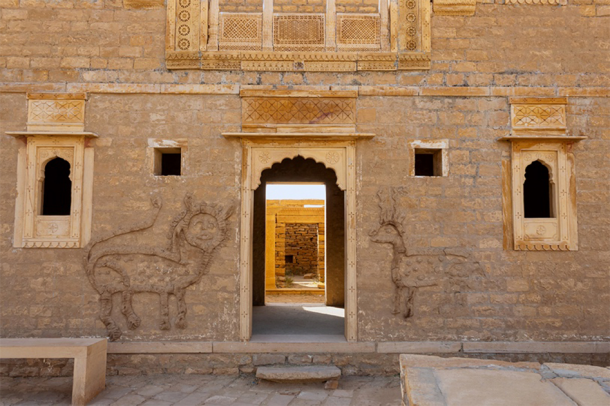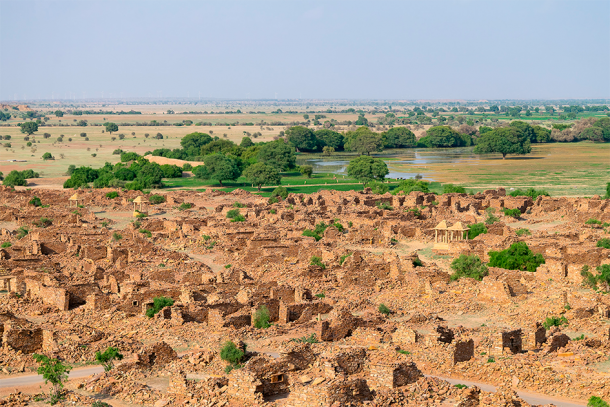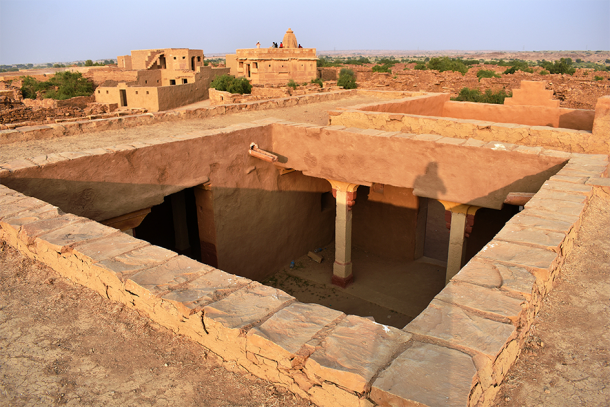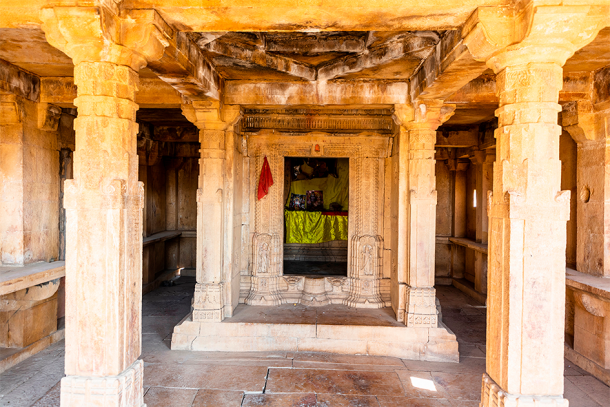The Indian village of Kuldhara is shrouded in mystery. Once a prosperous and thriving community, the village was suddenly abandoned in the 19th century and has remained uninhabited ever since. According to legend, the village was cursed by its inhabitants before they fled, due to the actions of a powerful and cruel Rajput ruler. So what really happened to the people of Kuldhara, and is there any truth behind its fabled curse?

Abandoned remains of a house at Kuldhara in India. ( RealityImages / Adobe Stock)
Kuldahara: A Prosperous Oasis Lost to History
Kuldhara, a forgotten village nestled in the heart of Rajasthan, India, was once a thriving community of Paliwal Brahmins renowned for their agricultural prowess and water management skills. Transforming the barren land into a lush oasis, they turned it into one of the most prosperous regions in the area.
The Brahmins thrived there for many years, until the village’s fortunes took a dark turn in the 18th century with the arrival of the tyrannical Rajput ruler, Salim Singh. Dubbed the monster of Jaisalmer, Singh’s extortions and cruel demands, particularly his obsession with the daughter of Kuldhara’s chief, allegedly led to the mass abandonment of the village and several others nearby.
It’s important to note that this latter part of their history is entirely based on legend. Though the villagers left behind no concrete evidence of their reasons for leaving, the rumors of a curse placed upon the hamlet by the departing villagers still persist to this day. While it remains uninhabited, its ruins standing as a haunting reminder of a once-thriving community and the mysterious circumstances surrounding their departure.

Aerial view of the abandoned village of Kuldhara in Rajasthan in India. ( Nicola78/Wirestock Creators / Adobe Stock)
The Dark and Twisted Curse of Kuldhara: Fact or Fiction?
According to the legend, cruel ruler Salim Singh took a keen interest in a young girl in the village. The villagers, unwilling to give up the frightened girl, banded together and decided to abandon the village and flee to prevent him from taking her for himself. Before leaving, they supposedly placed a curse on the village so it would remain uninhabited forever. Thanks to the curse, anyone who tried to settle there after their departure would be doomed to misfortune and ultimately, failure.
Ever since its abandonment, the village has remained uninhabited. Many believe that this is the result of the curse still being in effect. Visitors to the village often report feeling uneasy and experiencing strange occurrences, such as ghostly sightings and unexplained noises. A sense of unease hangs over the village, resulting in some fleeing the area without exploring further.
Some even claim that the village’s crumbling streets are haunted by the lingering spirits of the villagers who were forced to abandon it. It is important to note that these feelings are often subjective and may be influenced by one’s expectations and personal beliefs about the curse or the history of the village.
Other visitors have gone into the village with a sense of fascination and curiosity, managing to leave without any ghostly encounters. Ultimately, the curse of Kuldhara is a legend and is not supported by any concrete historical facts. So why did the people of Kuldhara truly leave, and where did they go?

The abandoned village of Kuldhara in India. ( SONAL / Adobe Stock)
Archaeology Provides a Glimpse into Understanding Kuldhara’s Prosperous Past
Historians have proposed several potential reasons why the village of Kuldhara was actually abandoned. One reason is the poor economic conditions the villagers may have faced at the time. Singh’s cruelty and persecution may have resulted in financial hardships for the people through increased taxes and harassment from the harsh ruler’s officials. It is also possible that the villagers were facing environmental hardships such as a drought, which would have made leaving inevitable.
Archaeological studies of the village have provided a small glimpse into its past, revealing a well-planned and sophisticated settlement. Excavations have uncovered the remains of houses, streets and a complex water management system, indicating that the village was once fully self-sufficient. This water system included a network of canals and dams that were used to collect and distribute water for irrigation and household use.
Having such a complex and sophisticated water and drainage system also proves that the region frequently faced environmental conditions such as droughts, as they needed other ways to bring water in over time. Archaeologists were impressed upon finding this system, as it meant that the village was once quite prosperous.
Artifacts such as pottery and tools have also been found, providing some insight into the daily lives of the villagers. Unfortunately, none of these findings has resulted in any sort of solid conclusion about the fate of the villagers who fled the region. While we may know more about what the village was like when inhabited, there is little evidence pointing historians to where they went, or why.

Ruined remains at Kuldahara in India. ( Andrea / Adobe Stock)
Given the information they have now, most historians believe that the villagers left for a combination of environmental and political reasons. With a water system relying on rainfall and political persecution at every turn, it is unlikely that the inhabitants of Kuldhara felt the desire to stay there long-term. Whatever truly happened to the population in Kuldhara remains largely unknown, which has only resulted in more rumors spreading about its curse.
In Search of the Truth: Is the Mystery of Kuldhara a Cold Case?
Though the village of Kuldhara is certainly shrouded in mystery, there is still no concrete evidence to support the legend behind its abandonment. Today, the village is known as a popular tourist spot for history buffs and paranormal enthusiasts drawn to its eerie history. We may never know what truly happened to this mysterious village, but further exploration of its ghostly ruins may bring us one step closer to figuring it out.
Top image: The ruined remains of Kuldhara village in India. Source: bluesea / Adobe Stock
By Lex Leigh
Related posts:
Views: 0
 RSS Feed
RSS Feed

















 March 19th, 2023
March 19th, 2023  Awake Goy
Awake Goy  Posted in
Posted in  Tags:
Tags: 
















